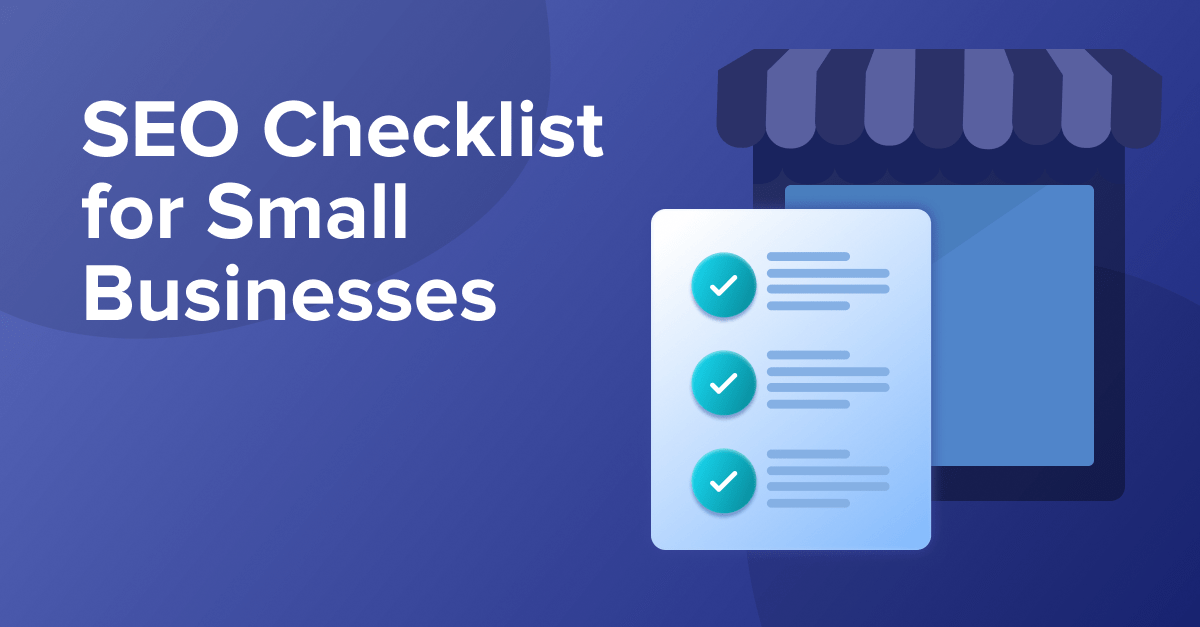
SEO can be challenging for all types of companies, but small businesses have it harder than most. Even if you’ve got a smaller budget and fewer resources available, you must work just as hard as bigger companies to rank well in search.
It’s no surprise that many small businesses are frustrated with Google and SEO in general. Unfortunately, this encourages a lot of companies to look for shortcuts, which only makes matters worse.
Instead, smaller businesses should focus on doing the basics well and building on solid foundations. This way, everything you spend on SEO today will continue to be the basis to generate ROI for years to come.
This SEO checklist for small businesses covers all the essentials to get you started on the right track!
1. Know who you’re optimising for & why
The first item in our checklist might seem obvious, but it’s absolutely critical:
Before you spend any money on SEO, make sure you know who you’re optimising for and why.
Many small and new businesses simply think of SEO as a strategy that generates website traffic. This isn’t entirely wrong, but it is overly simplistic, limiting the impact SEO can have, and it can lead you down the wrong path. Instead, think of SEO as a strategy that puts your business in front of the right kind of people, aiming to land them on your website to convert.
To generate the right type of traffic and get in front of the right type of people, you need to know who you’re targeting and how they use Google to find businesses, products, or services like yours.
We recently published an article on the Vertical Leap website explaining how to get found on Google Search in 2024. At this point, there are nine places on the main Google search engine where a link to your site might be displayed:
- Organic blue links (i.e. Google’s “regular” search results)
- Local packs
- Google Maps
- Product listings
- Featured snippets
- SGE AI-generated snippets
- People also ask
- Discover
- Image search
Many SEO beginners are focused on the “organic blue links” at first, which is a good place to start with, but it’s important to consider that – depending on your business – the other placements can offer great opportunities as well. That’s why it’s so important to know where your target audience is discovering brands like yours, so you know what type of content you have to create.
For example, if you run a local business, many customers will probably discover you through the Local Pack / Google Maps results:
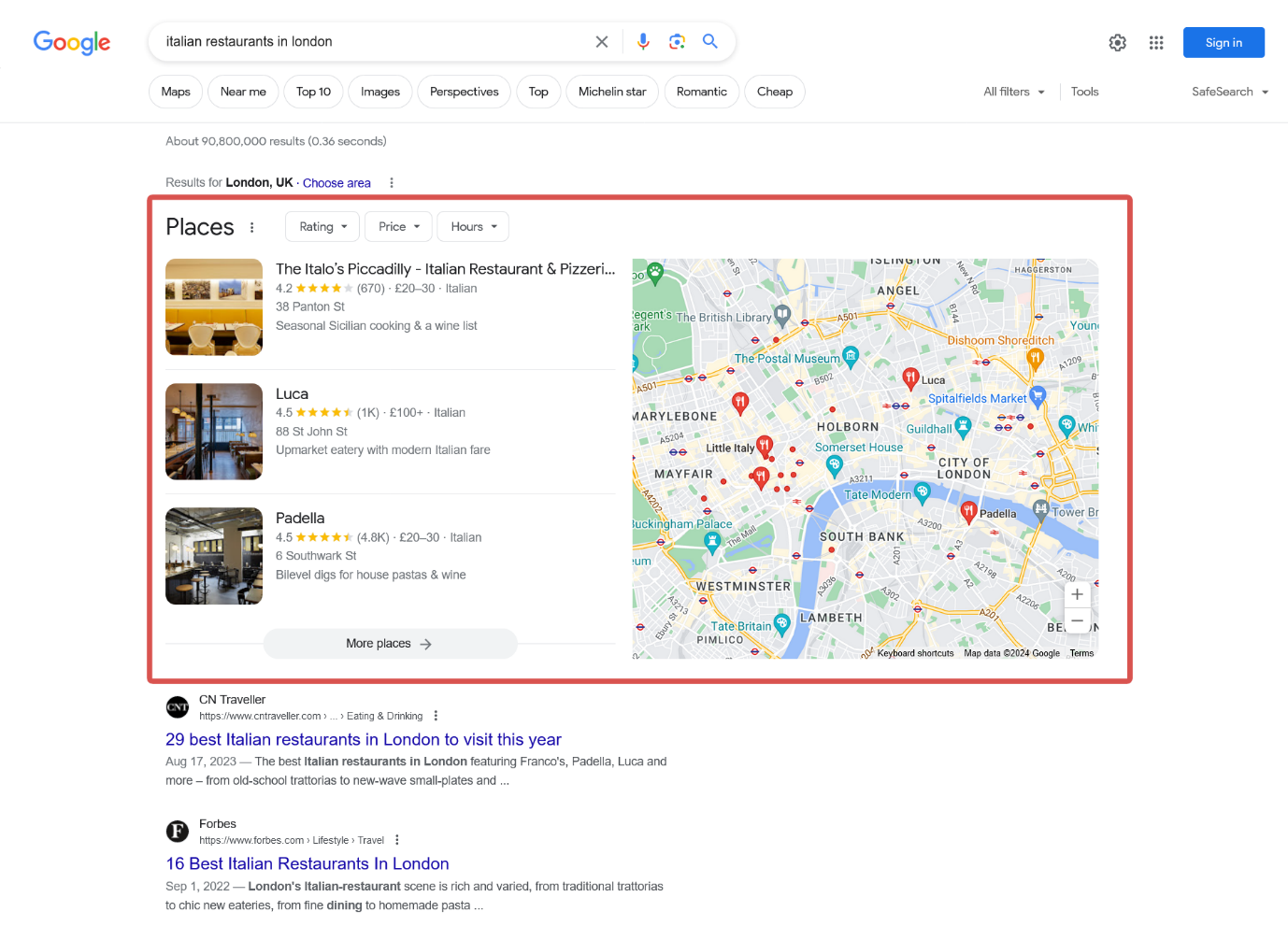
That’s why it’s important to prioritise your Google Business Profile, which is the most important ranking factor for this section of the SERPs.
In a nutshell: Don’t just go down the list and try to optimise everything. Think about what areas need to be your priorities.
If you’re not sure which approach is right for your business, take a look at this previous article exploring SEO strategies for different types of small businesses.
Know Your Audience
If SEO is about bringing the right kind of visitors to your website, you have to know who you’re targeting. This starts with audience research: who they are, what they’re looking for, and where they go to find it.
Imagine a B2B software company putting most of its SEO budget into blog posts and affiliate articles. This is great, but what if its biggest target audience is discovering most new products on LinkedIn and YouTube before they even turn to Google? By not knowing its target audiences, this company is missing out on a lot of leads, many of whom are probably discovering rival products on their favourite platforms.
To truly understand your target audience(s), combine data from all the relevant sources you can. This will likely include:
- Google Analytics 4 (demographics)
- Internal customer data
- Customer feedback, surveys
- Social media audiences
- Consumer surveys, studies, etc.
- Competitor audience analysis
If you’re also running PPC and other forms of paid ads, take full advantage of the audience data available from platforms like Google Ads and Meta for Business.
Learn as much as you can about your audience so you can make more informed decisions at later stages of this checklist.
2. Identify SEO opportunities
Small businesses can’t afford to waste budget, time, or other resources on failed campaigns, especially early on when every part of the budget counts. You need to build momentum quickly by identifying the right SEO opportunities for early potential gains.
To identify these SEO opportunities, keyword research will be your best friend.
Aside from revealing the queries your target audience types into the search engines, keyword research also reveals your customer’s broader intentions and how they change as they move from one stage of the customer journey to the next.
Keyword research for small businesses can be broken down into three components:
- Listing your seed keywords
- Spotting relevant keyword opportunities
- Prioritising keywords with the most potential
While Seobility’s keyword research guide covers these steps in more detail, we have summarised the most important points here.
Step 1: Start by listing your seed keywords
Seed keywords are the main terms your target audience is searching for.
While they differ for every business, brainstorming them for your own company begins with these three questions:
- Who is your product’s primary target group, and what are their needs?
- What are the key themes that emerge from your products and services, and how can you categorize them?
- What questions is your target group asking about these themes?
Asking yourself these questions will help you create a list of seed keywords and questions your customers ask, which will serve as a starting point for the next steps.
Step 2: Spot relevant keyword opportunities
To identify relevant keywords, take your seed keyword list and start by putting one of them into Seobility’s Keyword Research Tool.
For example, if you were selling massage ****, one seed keyword could be “buy massage gun”, so you would put that into the Keyword Research Tool.
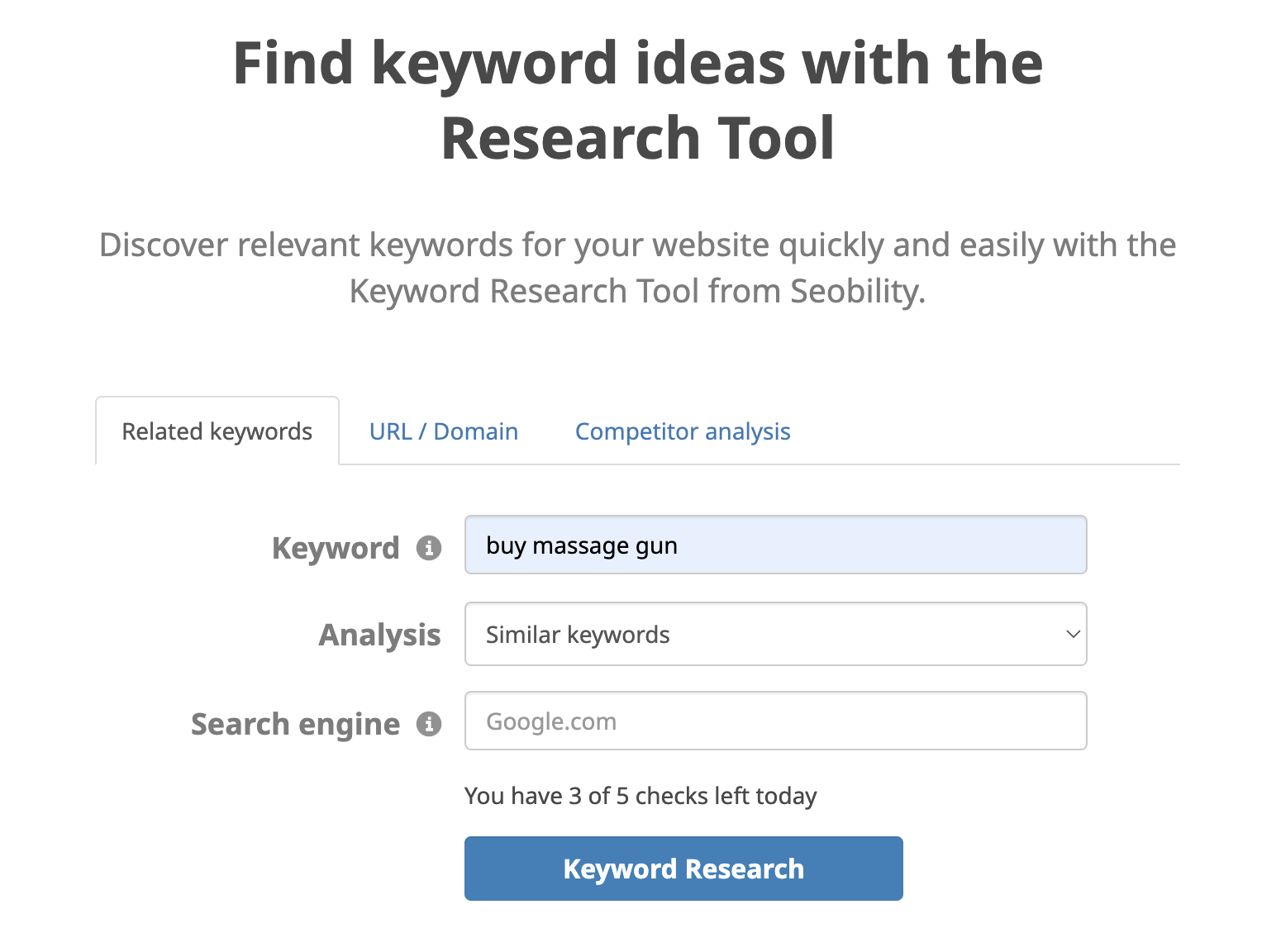
From the Keyword Research Tool, select “Similar keywords” for the Analysis and click on “Keyword Research” and you will get a list of relevant keywords to target.
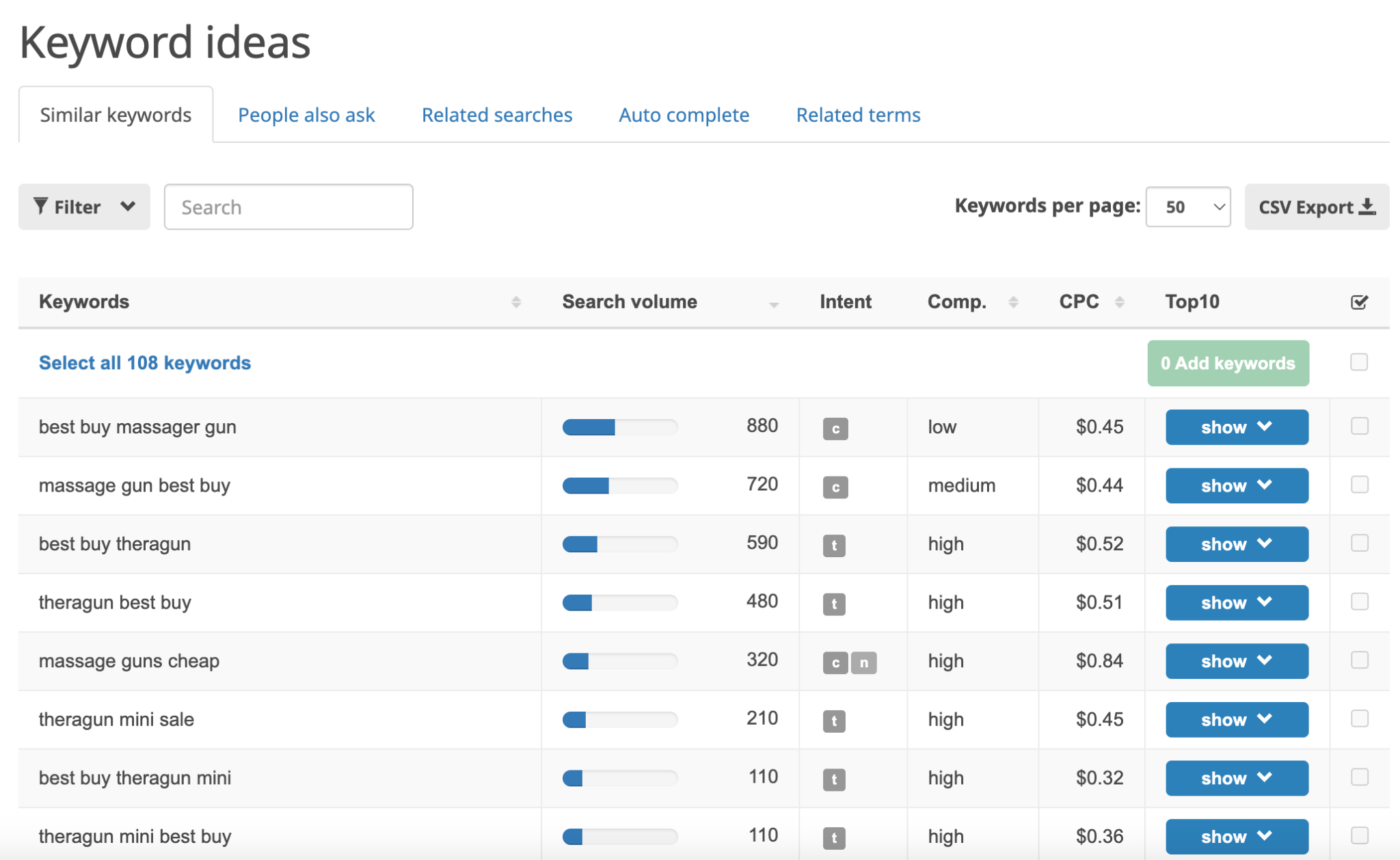
Another option to find keyword opportunities is to analyse the keywords that your competitors are targeting. To do this, simply enter a competitor’s domain in the tab “URL / Domain” of the Keyword Research Tool:
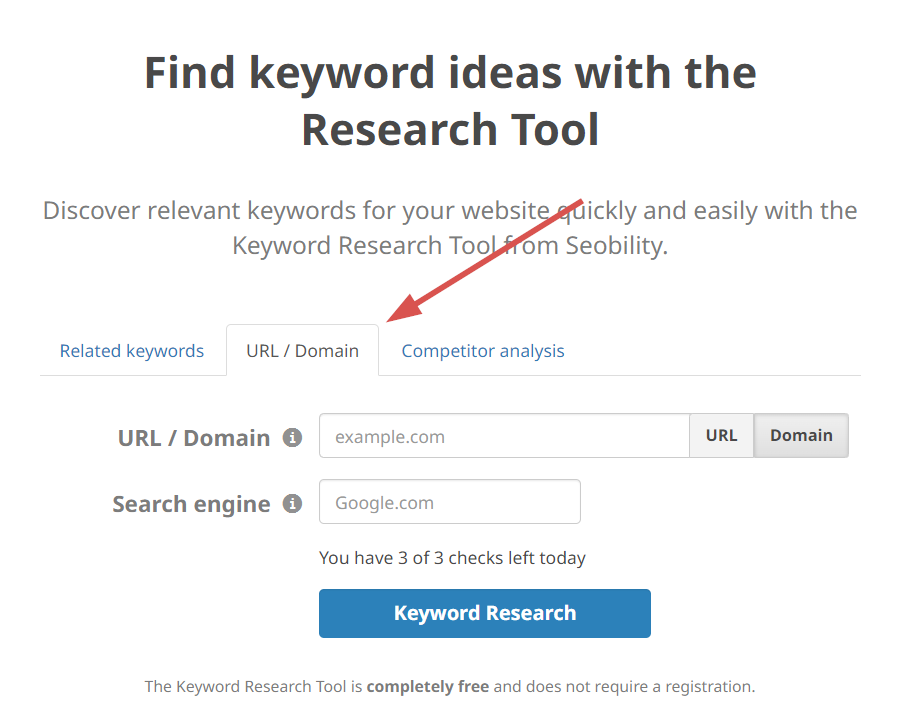
This will show you the keywords that drive traffic to your competitor’s website.
Step 3: Prioritise the most potential keywords
Seobility’s Keyword Research Tool gives you four metrics that will help you spot the right keyword opportunities:
- Search volume. This is an estimate of the number of searches per month. The higher the search volume, the more traffic you can attract; however, it also means more competition, which makes ranking high more difficult.
- Competition. The competition metric tells you whether the competition for a keyword is low, average, or high. If the competition is high, it means that a lot of websites are trying to rank for that keyword.
- CPC (cost per click): This price represents the approximate cost of a Google Ad for the phrase. It’s the amount you would have to pay if a user clicked on your ad. The more advertisers that bid for a keyword, the higher the CPC.
- Search intent. Search intent basically means what the searchers want from the search. Do users want to purchase something, find information on a topic, learn about a product, or navigate a website?

To pick the right keywords, start by looking into the search intent.
Search marketers usually group search intent into four key types:
- Navigational intent: Users are looking for a specific site/page (e.g.: “facebook login”).
- Informational intent: Users are looking for information, answers, help, etc. (e.g.: “how to change a lightbulb”).
- Commercial intent: Users are researching for a purchase decision (e.g.: “best energy-efficient light bulbs”).
- Transactional intent: Users intend to make a purchase/transaction during this session (“60w equivalent standard a15 bulb”).
Identifying specific search intents is crucial for creating the right type of content for the entire customer journey. For example, you don’t want to create overly promotional content for users who are still in the information stage of the research process and more interested in product comparisons than reviews and product pages.
Pick out and list keyword opportunities from all of the search intent groups. If you only focus on one search intent area, such as informational keywords, you don’t cover the entire customer journey, and you miss out on essential keyword opportunities.
To discover commercial intent keywords, for instance, look for keywords with words like buy, cheap, deal, affordable, sale, and so on.
Once you have a list of keywords from all groups, you can prioritise them based on the other metrics, search volume, competition, CPC, and other factors, such as the relevancy to your audience.
And, if you need further help with keyword intents, Saša Ebach wrote an excellent blog post on optimising content for searchers’ needs.
3. Optimise your website
Your website is the hub of your online presence and SEO strategy. Before you invest any serious money in content production, make sure you’ve got the website SEO essentials nailed down first. This will help each new content asset created work more effectively and contribute more towards your goals and objectives.
The most important tasks of website optimisation include
- Ensure a flawless technical SEO setup
- On-page SEO
- Optimising your content
- Optimising user experience
Ensure a flawless technical SEO setup
Technical SEO ensures search engines like Google can crawl and index your pages properly. It also helps to optimise technical performance to provide a smooth experience for visitors and search engines alike.
Here are some of the most important technical SEO factors you need to analyse and maintain:
This isn’t the most exciting aspect of SEO, but it is one of the most important to underpin success. If technical SEO falls behind, the rest of your SEO strategy isn’t making the full impact it could – and that’s a serious waste of budget.
Thankfully, with the right tools, you can automate technical SEO analysis so you don’t have to check all of these factors individually, and issues are flagged instantly. With Seobility’s Website Audit Tool, you can schedule automatic comprehensive technical SEO audits and flag any problems.
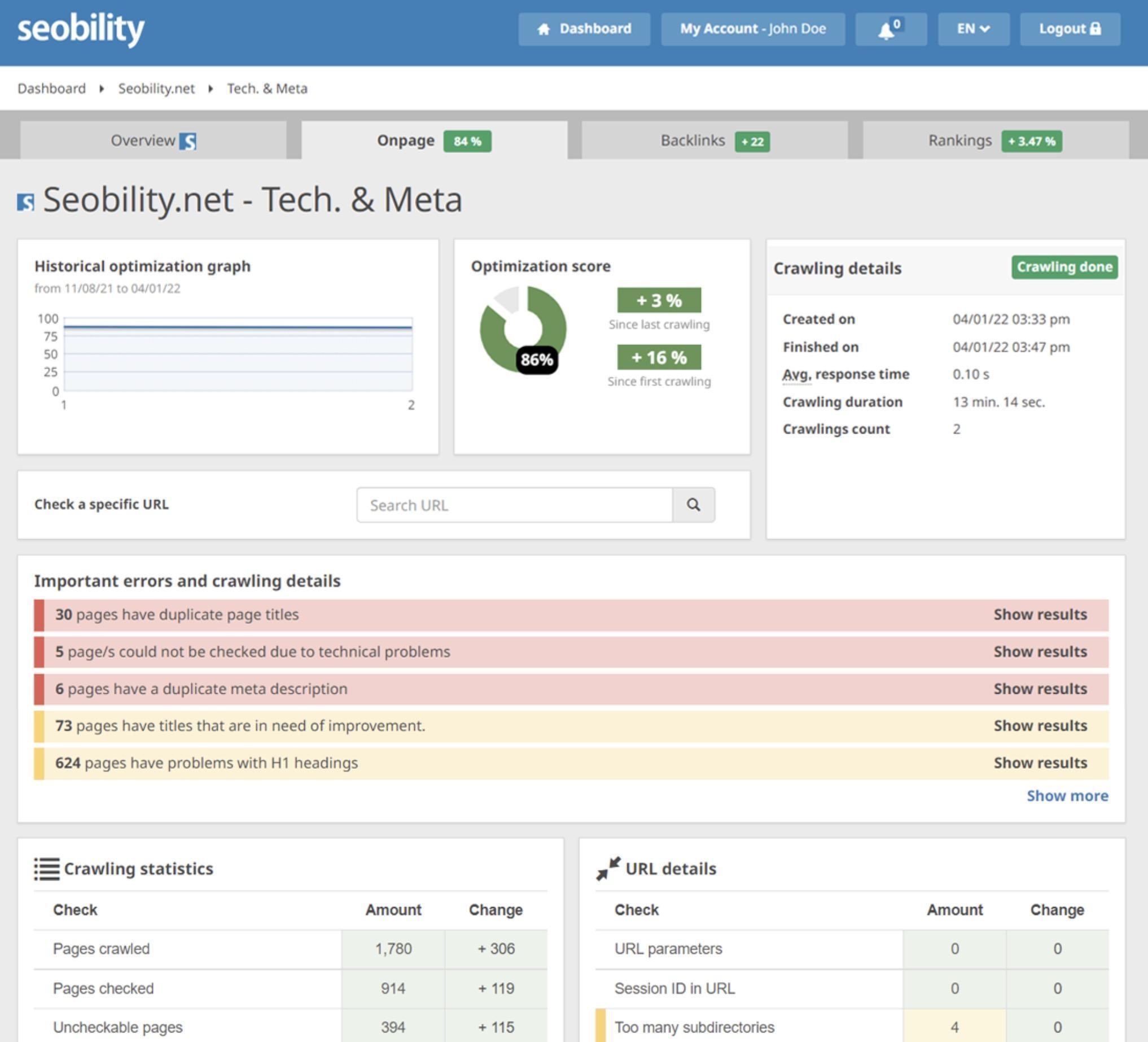
As long as you address these issues quickly, they’re unlikely to cause too much damage to your search ranking. This can give you a big advantage over small business rivals who aren’t keeping on top of technical SEO.
Improve Your On-page SEO
Once all technical issues are resolved, there are several on-page SEO factors that should be optimised on each page of your website:
- Optimised title tag
- Optimised H1 heading
- Correct use of sub-headings: H2, H3, etc.
- Compelling meta description
- Clear, logical page structure
- Natural use of keywords in headings and content
- Appropriate use of bullet points, numbered lists and images
- Internal links to important, relevant pages
- External links to authoritative sources
- Short, concise paragraphs – ideally, no more than 300 words per heading
- Excellent content quality: relevant, accurate and unique
As with the technical SEO factors, Seobility’s Website Audit will automatically check many of these on-page SEO factors on your complete website, such as your title tags and meta descriptions:
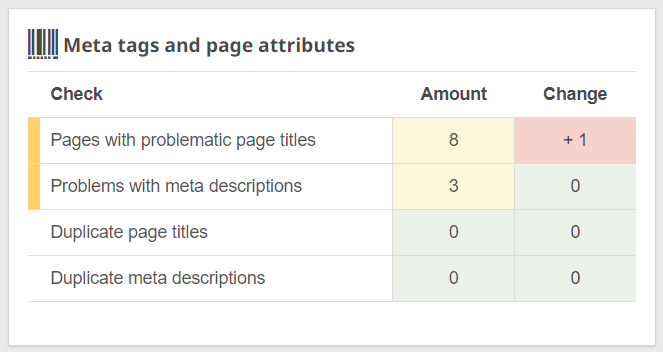
You should also make sure that this on-page SEO checklist is complete before publishing any new pages to your website (blog posts, landing pages, etc).
As you update existing content, you’ll also need to maintain on-page SEO factors. For example, make sure every post contains accurate, up-to-**** information and links to recent external sources (no older than two years).
Create high-quality and optimized content
Content is usually the most expensive and time-consuming aspect of SEO. As a small business, you need to be particularly resourceful to get the most impact from everything you publish.
Prioritise quality over quantity, and don’t fall into the trap of trying to do too much with a limited budget. Choose your battles wisely and concentrate on winning them, one at a time.
- Content opportunity analysis: Incorporate all of the opportunity analysis tips we’ve discussed above to pinpoint high-value content opportunities.
- Reward vs difficulty: Calculate the potential reward and difficulty of every content opportunity – make sure they’re worth it and realistically achievable. This can be based on looking at the level of competition and the search volume for the keyword you’re looking to target and not targeting highly competitive keywords that you have no chance to rank for.
- Search intent & relevance: Make sure you understand the true search intent for everything you publish. Each piece of content should be 100% relevant to your target audience and their intent.
- Accuracy: Accurate information is the most important quality for building and maintaining trust with your audience and search engines.
- E-E-A-T: Follow Google’s guidelines for Experience, Expertise, Authoritativeness and Trustworthiness.
- Content audits: Get long-term value from everything you publish and maximise performance with regular content audits/updates (more on this later).
- Actionability: Use CTAs and internal links strategically to keep users on your site and moving towards conversion goals.
For a more in-depth look at SEO content, take a look at this recent article explaining how smaller companies can do content marketing like big businesses.
Perfect Your User Experience
It doesn’t matter how great your content is if the user’s experience on your website is so poor that they click straight back to Google search. Google, in particular, knows how important user experience is for search, which is why it’s incorporated so many UX signals into its algorithm over the years:
- Mobile-friendliness
- Navigation
- Loading times
- Secure encryption (HTTPS)
- Page experience, including Core Web Vitals and the absence of Pop-ups/Intrusive ads
Keep in mind that this only covers the SEO essentials for user experience. You have to work much harder to satisfy users themselves, especially if you want them to fill out forms, make payments, buy products, and keep coming back for more.
The greatest tip on how to achieve this is to think about imparting value in everything you do.
A person landing on a complex blog post, for example, may benefit from some definitions of industry jargon, links through to related content, and other types of content like images and videos to help with their understanding of the topic:
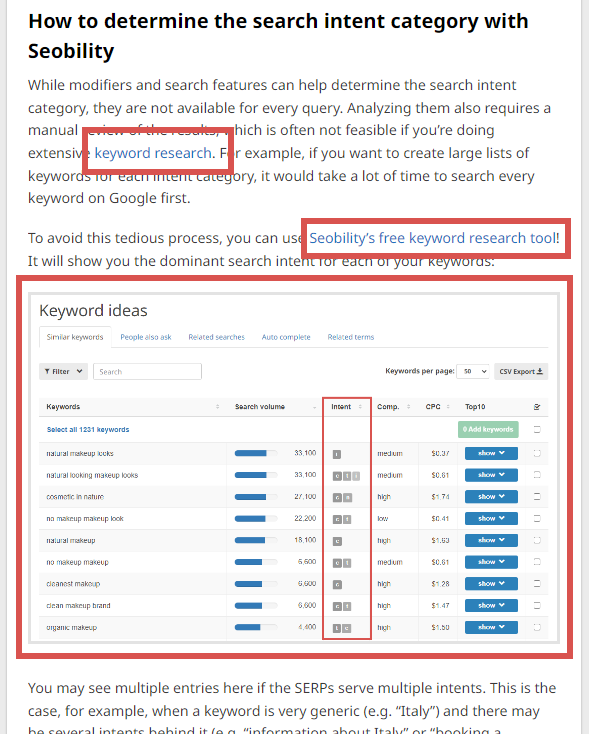
If you have pages on your website that have higher bounce (or exit) rates, take the time to look at the data about the people using these pages. Consider the queries they are using to find the content online and what they are trying to achieve. Then, consider how valuable the content is matching their wants, needs and pain points, and how to provide more value to what they are looking to achieve.
Applying this layer of human understanding will form a great basis for your user experience.
4. Optimise Off-page SEO factors
So far, we’ve focused on optimising your website and the content on it, but to maximise visibility, your online presence needs to spread beyond your website. Links from other websites (aka backlinks) are still an important factor for a high ranking on Google. And on top of that, off-page SEO connects you with audiences outside of search engines and helps build your brand.
There are four key elements to this, and as with many items for small businesses specifically, you’ll want to prioritise these and gradually check them off:
- Backlinks
- Direct traffic
- Brand mentions
- Off-site engagement
Whilst these 4 areas may differ in regards to which to begin with, I’d suggest taking a look at backlinks first in many cases.
Start Building Your Backlink Profile
There are different ways to start creating backlinks and the effort and money you need to invest can be adjusted to fit your situation.
If you’re creating the best content in your niche, you should naturally earn quality backlinks from valuable sources. However, as a small business that doesn’t have a strong brand and reach yet, it can be hard to attract these kinds of links from the very beginning.
Luckily, there are a few ways you can start building backlinks and growing a reputation in your niche.
Engage in Guest Blogging
Posting your content on third-party websites (guest blogging) is one of the easiest ways small businesses can get started building up their backlink profile.
You can start with simple steps, such as connecting with other companies in your niche through LinkedIn and asking if they’re willing to collaborate on content.
However, don’t only think about backlinks when partnering with other sites. Also, consider their audience and getting your brand/content seen by the right people in places you don’t yet have visibility.
Sometimes, the brand awareness and click-throughs from guest blogs are more valuable than backlinks and the ranking boost.
Create ‘Link Bait’ Pages
The term linkbait refers to content designed to attract the audience’s attention and generate new links.
Seobility’s free Backlink Checker is a great example of a link bait page as it provides a lot of value for free.
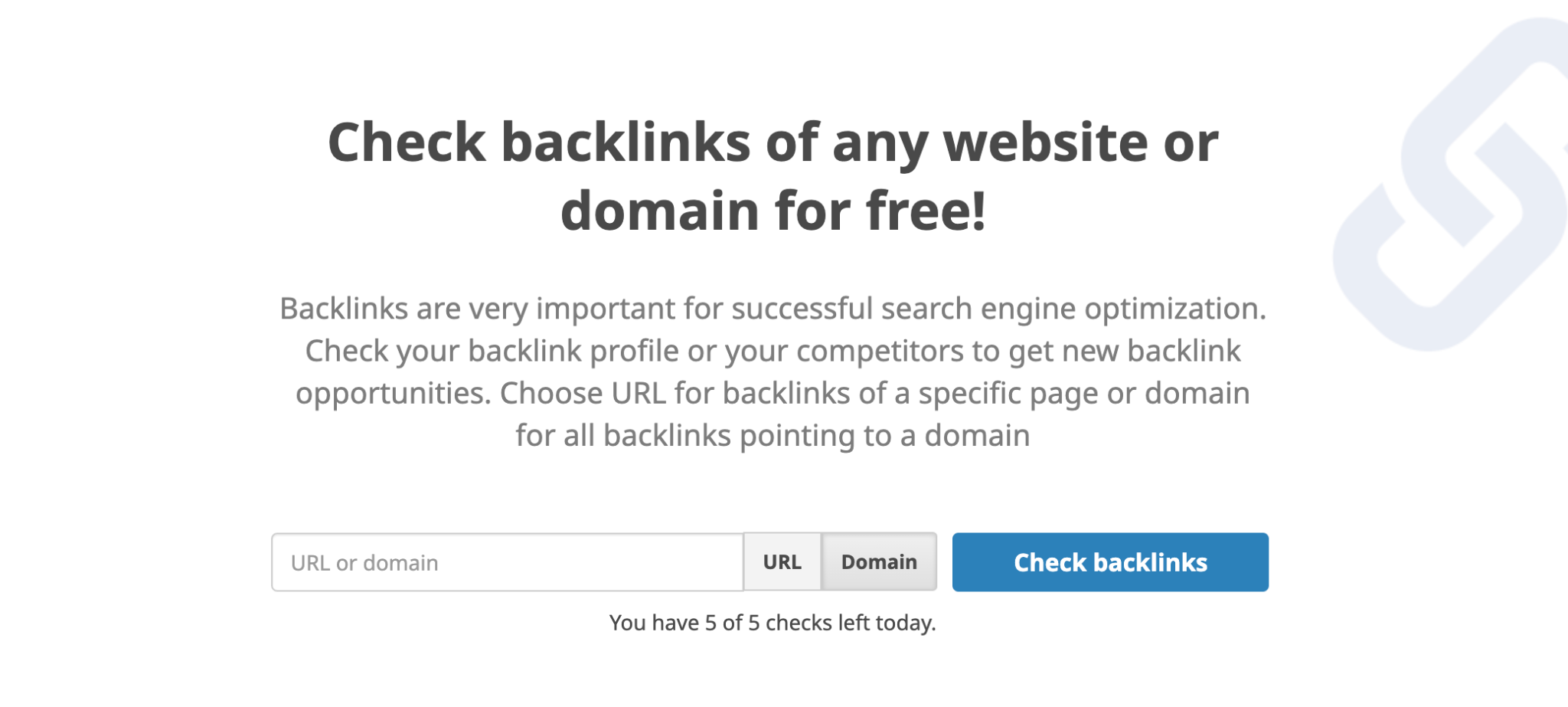
In the same way, you can make link-bait pages within your own niche where your target audience is naturally inclined to link because it is so valuable.
Of course, you don’t have to learn how to code in order to use this strategy. Besides offering free tools, there are other options for creating linkbait content, such as statistics, surveys, and more. This article by Seobility provides great ideas for how to build high quality backlinks.
Analyse your competitors’ links
Analysing your competitors’ backlink profiles can be a great source of inspiration for your own link building strategies. With Seobility’s free Backlink Checker, you can easily identify the pages that link to your competitors’ websites.
You could even try to “steal” your competitors’ links by creating content that’s better than theirs, contacting the sites that link to them, and offering your content as an alternative.
Maintain your backlink profile
Building new quality links is one of the most important things for improving your search ranking, but the links are useless if they are lost or are of bad quality.
Plus, if you can maintain your backlinks and you don’t lose them, at times you can put less effort into building new backlinks if other things need your attention.
Seobility’s Backlink dashboard provides all the insights you need to manage your website’s backlink profile:
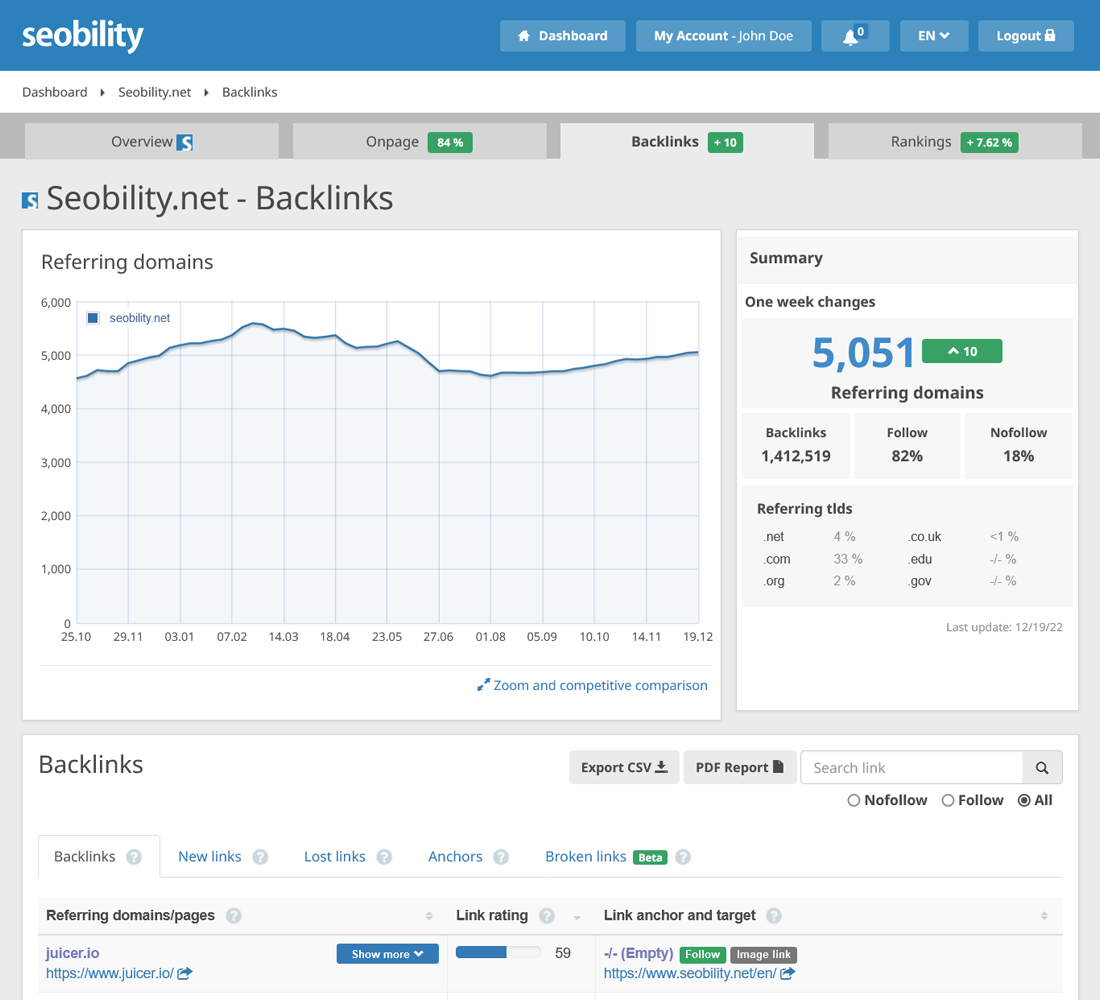
There are two important factors to consider:
- Value of your links (Link rating): Seobility automatically analyses the links pointing to your site, telling you how valuable every link is/isn’t. As the site owner, you should keep an eye on the quality of your links and adjust your strategy accordingly. For example, if the majority of your links are bad quality, you may need to change the companies you collaborate with on building backlinks.
- Lost backlinks: Seobility also flags any lost backlinks that no longer point to your website. If this happens to you, you can take appropriate action to gain the link back, such as contacting your content partner for the reasons the link was removed. Many times, they may even do this by accident.
Take Advantage of Direct Traffic
Direct traffic describes sessions where the user visits your website by typing a URL into their browser bar, instead of clicking through from a search engine or third-party source. Google has said many times that direct traffic is not a ranking factor, but this doesn’t mean it isn’t important.
Building brand awareness with SEO and non-SEO campaigns should result in higher levels of direct traffic. This is a strong indicator that your SEO strategy is working, while greater brand awareness also encourages more users to click on your results when they show up in search.
You can increase brand awareness in many ways, and this includes both offline and online activities.
Part of this can be as simple as being more active in the community, online forums, and main social media channels specific to your industry. A useful way to achieve this is by answering people’s questions and educating them on areas of expertise that are relevant to your business offering.
Reddit is an example of an online forum where you can engage with communities on almost any topic you can think of:
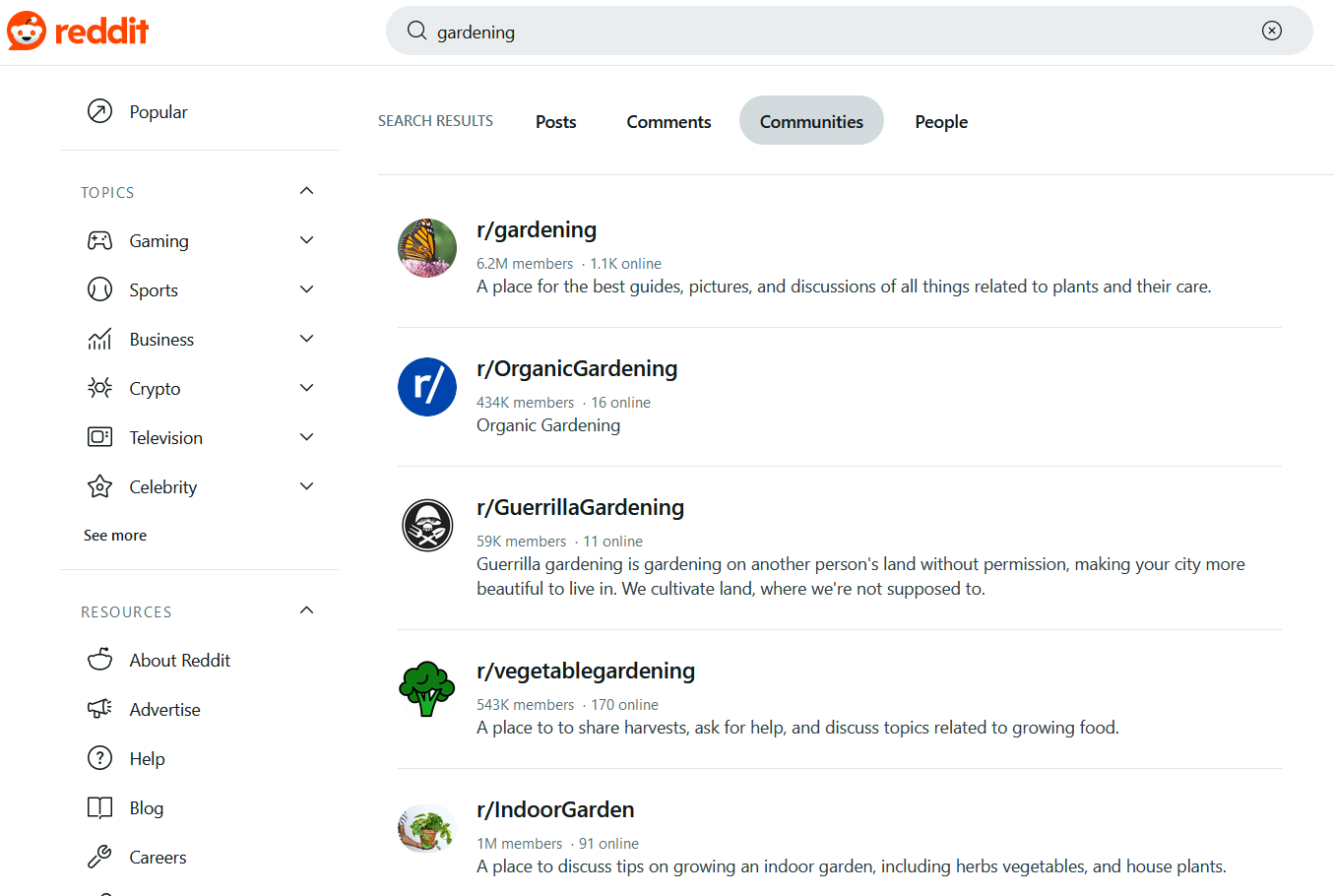
You can also bring your brand in front of wider audiences by becoming more active in networking events (again, this can be both online and offline). Consider even hosting your own events, such as workshops, webinars, or educational sessions that are related to your business.
By being actively involved in scenarios where you are able to shine a light on your expertise and key staff, you can introduce your brand to engaged audiences in a value-based way.
Get People Talking: Brand Mentions
Brand mentions are also incorrectly cited as a ranking signal, but only because their value is misunderstood. Like direct traffic, brand mentions (without links) are indicative of brand awareness, although they don’t generate any traffic. Meanwhile, brand mentions with links are backlinks with branded anchor text – very valuable from authoritative sites but not considered brand mentions. Both are valuable but in very different ways.
As with direct traffic, building brand awareness in the ways described in the previous section is the key to generating brand mentions.
Build Off-site Engagement
Off-site engagement refers to all interactions with your brand that take place outside of your website:
- Social media accounts
- Google Business Profile
- Directory listings
- Guest blogs
- Review websites
- Forums (Quora, Reddit, industry forums, etc.)
- Third-party apps (Deliveroo, TripAdvisor, etc.)
- Email inboxes
- Offline interactions
All of these interactions contribute to brand awareness, visibility, the customer experience and your SEO strategy – some directly, others indirectly.
But don’t worry, you don’t have to take on all of these at once. Instead, you can pick one area to focus on and start building your off-site engagement from there.
For example, you can start sharing your thoughts on platforms like LinkedIn, which can later lead to SEO opportunities like content collaborations.
5. Bringing it all together: Analysis & optimisation
In this article, I’ve condensed small business SEO into four basic steps:
- Know who you’re optimising for and why
- Identify SEO opportunities
- Optimise your website
- Optimise off-page SEO factors
But there’s one final item on this checklist:
Keep Analysing and Optimising Your SEO Performance
The key element that brings this all together is ongoing analysis and optimisation.
SEO isn’t a set-it-and-forget-it marketing strategy. It’s an ongoing process of creating quality content assets and constantly optimising them to enhance/maintain performance:
- Tool selection: Start by integrating the right mix of SEO tools to monitor your performance– e.g.: Seobility, Google Analytics 4, Search Console, etc.
- SEO attribution: Make sure you can attribute SEO activities to profitable business goals (leads, conversions, sales, etc.) so you know what’s really working. Analytics packages such as Google Analytics enable you to track everything from telephone clicks on your website, through to PDF downloads and completed forms. The more you measure the impact of these items, the easier it becomes to attribute the impact that SEO has commercially on your business.
- Website performance: Constantly monitor and optimize the performance of your website – search rankings, keyword coverage, user experience, conversions, etc.
- Technical SEO: Set up automatic technical audits to identify any crawl/indexing issues, broken links, and other issues instantly – so you can address them before they harm your search ranking.
- Content audits: Run annual content audits to identify your best and worst-performing pages, duplicate content, and pages competing for the same keywords – update your best content to maintain performance, merge competing pages, and remove anything that’s not worth saving.
Focus on doing a really good job of everything we’ve covered in this article. By the time you cross off everything on this checklist, your SEO strategy will be making a bigger contribution to your business, and you’ll be ready to start implementing more advanced strategies. Don’t try to rush things; concentrate on building (and maintaining) solid foundations first – because the more advanced strategies fall apart without them.
Want to learn more about SEO for small businesses? Check out the other articles in this series:
And if you’re not using Seobility yet, sign-up for a free 14-day trial of Seobility Premium here to run technical and on-page SEO audits, monitor your rankings, analyse your backlink profile, and more.
PS: Get blog updates straight to your inbox!
Source link : Seobility.net
